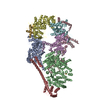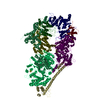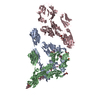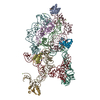+ データを開く
データを開く
- 基本情報
基本情報
| 登録情報 | データベース: PDB / ID: 6nmi | |||||||||||||||
|---|---|---|---|---|---|---|---|---|---|---|---|---|---|---|---|---|
| タイトル | Cryo-EM structure of the human TFIIH core complex | |||||||||||||||
 要素 要素 |
| |||||||||||||||
 キーワード キーワード | TRANSCRIPTION / DNA repair / helicase / multiprotein complex | |||||||||||||||
| 機能・相同性 |  機能・相同性情報 機能・相同性情報MMXD complex / core TFIIH complex portion of holo TFIIH complex / Cytosolic iron-sulfur cluster assembly / central nervous system myelin formation / positive regulation of mitotic recombination / hair cell differentiation / hair follicle maturation / ventricular system development / nucleotide-excision repair factor 3 complex / nucleotide-excision repair, preincision complex assembly ...MMXD complex / core TFIIH complex portion of holo TFIIH complex / Cytosolic iron-sulfur cluster assembly / central nervous system myelin formation / positive regulation of mitotic recombination / hair cell differentiation / hair follicle maturation / ventricular system development / nucleotide-excision repair factor 3 complex / nucleotide-excision repair, preincision complex assembly / CAK-ERCC2 complex / transcription factor TFIIK complex / UV protection / embryonic cleavage / adult heart development / DNA 5'-3' helicase / G protein-coupled receptor internalization / regulation of cyclin-dependent protein serine/threonine kinase activity / transcription factor TFIIH core complex / transcription factor TFIIH holo complex / cyclin-dependent protein serine/threonine kinase activator activity / nuclear thyroid hormone receptor binding / RNA Polymerase I Transcription Termination / transcription preinitiation complex / regulation of mitotic cell cycle phase transition / DNA 3'-5' helicase / RNA polymerase II general transcription initiation factor activity / transcription factor TFIID complex / 3'-5' DNA helicase activity / spinal cord development / erythrocyte maturation / hematopoietic stem cell proliferation / RNA Pol II CTD phosphorylation and interaction with CE during HIV infection / RNA Pol II CTD phosphorylation and interaction with CE / bone mineralization / Formation of the Early Elongation Complex / Formation of the HIV-1 Early Elongation Complex / HIV Transcription Initiation / RNA Polymerase II HIV Promoter Escape / Transcription of the HIV genome / RNA Polymerase II Promoter Escape / RNA Polymerase II Transcription Pre-Initiation And Promoter Opening / RNA Polymerase II Transcription Initiation / RNA Polymerase II Transcription Initiation And Promoter Clearance / mRNA Capping / ATPase activator activity / regulation of G1/S transition of mitotic cell cycle / DNA topological change / intrinsic apoptotic signaling pathway by p53 class mediator / RNA Polymerase I Transcription Initiation / hematopoietic stem cell differentiation / embryonic organ development / Tat-mediated elongation of the HIV-1 transcript / Formation of HIV-1 elongation complex containing HIV-1 Tat / transcription by RNA polymerase I / transcription elongation by RNA polymerase I / Formation of HIV elongation complex in the absence of HIV Tat / Cyclin E associated events during G1/S transition / Cyclin A/B1/B2 associated events during G2/M transition / transcription-coupled nucleotide-excision repair / response to UV / Cyclin A:Cdk2-associated events at S phase entry / cyclin-dependent protein kinase holoenzyme complex / RNA Polymerase II Transcription Elongation / Formation of RNA Pol II elongation complex / isomerase activity / hormone-mediated signaling pathway / RNA Polymerase II Pre-transcription Events / extracellular matrix organization / DNA helicase activity / insulin-like growth factor receptor signaling pathway / maturation of SSU-rRNA from tricistronic rRNA transcript (SSU-rRNA, 5.8S rRNA, LSU-rRNA) / post-embryonic development / determination of adult lifespan / nucleotide-excision repair / positive regulation of smooth muscle cell proliferation / chromosome segregation / transcription initiation at RNA polymerase II promoter / TP53 Regulates Transcription of DNA Repair Genes / RNA Polymerase I Promoter Escape / transcription elongation by RNA polymerase II / promoter-specific chromatin binding / G1/S transition of mitotic cell cycle / cellular response to gamma radiation / NoRC negatively regulates rRNA expression / Dual Incision in GG-NER / Transcription-Coupled Nucleotide Excision Repair (TC-NER) / Formation of TC-NER Pre-Incision Complex / spindle / multicellular organism growth / Formation of Incision Complex in GG-NER / response to calcium ion / Dual incision in TC-NER / Gap-filling DNA repair synthesis and ligation in TC-NER / Cyclin D associated events in G1 / intracellular protein localization / RUNX1 regulates transcription of genes involved in differentiation of HSCs / 4 iron, 4 sulfur cluster binding / single-stranded 3'-5' DNA helicase activity / double-stranded DNA helicase activity 類似検索 - 分子機能 | |||||||||||||||
| 生物種 |  Homo sapiens (ヒト) Homo sapiens (ヒト) | |||||||||||||||
| 手法 | 電子顕微鏡法 / 単粒子再構成法 / クライオ電子顕微鏡法 / 解像度: 3.7 Å | |||||||||||||||
 データ登録者 データ登録者 | Greber, B.J. / Toso, D. / Fang, J. / Nogales, E. | |||||||||||||||
| 資金援助 |  米国, 米国,  スイス, 4件 スイス, 4件
| |||||||||||||||
 引用 引用 |  ジャーナル: Elife / 年: 2019 ジャーナル: Elife / 年: 2019タイトル: The complete structure of the human TFIIH core complex. 著者: Basil J Greber / Daniel B Toso / Jie Fang / Eva Nogales /  要旨: Transcription factor IIH (TFIIH) is a heterodecameric protein complex critical for transcription initiation by RNA polymerase II and nucleotide excision DNA repair. The TFIIH core complex is ...Transcription factor IIH (TFIIH) is a heterodecameric protein complex critical for transcription initiation by RNA polymerase II and nucleotide excision DNA repair. The TFIIH core complex is sufficient for its repair functions and harbors the XPB and XPD DNA-dependent ATPase/helicase subunits, which are affected by human disease mutations. Transcription initiation additionally requires the CdK activating kinase subcomplex. Previous structural work has provided only partial insight into the architecture of TFIIH and its interactions within transcription pre-initiation complexes. Here, we present the complete structure of the human TFIIH core complex, determined by phase-plate cryo-electron microscopy at 3.7 Å resolution. The structure uncovers the molecular basis of TFIIH assembly, revealing how the recruitment of XPB by p52 depends on a pseudo-symmetric dimer of homologous domains in these two proteins. The structure also suggests a function for p62 in the regulation of XPD, and allows the mapping of previously unresolved human disease mutations. | |||||||||||||||
| 履歴 |
|
- 構造の表示
構造の表示
| ムービー |
 ムービービューア ムービービューア |
|---|---|
| 構造ビューア | 分子:  Molmil Molmil Jmol/JSmol Jmol/JSmol |
- ダウンロードとリンク
ダウンロードとリンク
- ダウンロード
ダウンロード
| PDBx/mmCIF形式 |  6nmi.cif.gz 6nmi.cif.gz | 558.7 KB | 表示 |  PDBx/mmCIF形式 PDBx/mmCIF形式 |
|---|---|---|---|---|
| PDB形式 |  pdb6nmi.ent.gz pdb6nmi.ent.gz | 445.3 KB | 表示 |  PDB形式 PDB形式 |
| PDBx/mmJSON形式 |  6nmi.json.gz 6nmi.json.gz | ツリー表示 |  PDBx/mmJSON形式 PDBx/mmJSON形式 | |
| その他 |  その他のダウンロード その他のダウンロード |
-検証レポート
| 文書・要旨 |  6nmi_validation.pdf.gz 6nmi_validation.pdf.gz | 1.4 MB | 表示 |  wwPDB検証レポート wwPDB検証レポート |
|---|---|---|---|---|
| 文書・詳細版 |  6nmi_full_validation.pdf.gz 6nmi_full_validation.pdf.gz | 1.4 MB | 表示 | |
| XML形式データ |  6nmi_validation.xml.gz 6nmi_validation.xml.gz | 85.2 KB | 表示 | |
| CIF形式データ |  6nmi_validation.cif.gz 6nmi_validation.cif.gz | 130.3 KB | 表示 | |
| アーカイブディレクトリ |  https://data.pdbj.org/pub/pdb/validation_reports/nm/6nmi https://data.pdbj.org/pub/pdb/validation_reports/nm/6nmi ftp://data.pdbj.org/pub/pdb/validation_reports/nm/6nmi ftp://data.pdbj.org/pub/pdb/validation_reports/nm/6nmi | HTTPS FTP |
-関連構造データ
| 関連構造データ |  0452MC  0587C  0588C  0589C  0602C  0603C  0604C M: このデータのモデリングに利用したマップデータ C: 同じ文献を引用 ( |
|---|---|
| 類似構造データ | |
| 電子顕微鏡画像生データ |  EMPIAR-10430 (タイトル: Phase-plate cryo-EM of human TFIIH / Data size: 9.2 TB EMPIAR-10430 (タイトル: Phase-plate cryo-EM of human TFIIH / Data size: 9.2 TBData #1: Unaligned movies of human TFIIH, using the Volta phase plate, dataset 1 [micrographs - multiframe] Data #2: Unaligned movies of human TFIIH, using the Volta phase plate, dataset 2 [micrographs - multiframe] Data #3: Unaligned movies of human TFIIH, using the Volta phase plate, dataset 3 [micrographs - multiframe] Data #4: Unaligned movies of human TFIIH, using the Volta phase plate, dataset 4 [micrographs - multiframe] Data #5: Unaligned movies of human TFIIH, using the Volta phase plate, dataset 5 [micrographs - multiframe] Data #6: Unaligned movies of human TFIIH, using the Volta phase plate, dataset 6 [micrographs - multiframe]) |
- リンク
リンク
- 集合体
集合体
| 登録構造単位 | 
|
|---|---|
| 1 |
|
- 要素
要素
-General transcription and DNA repair factor IIH helicase subunit ... , 2種, 2分子 AB
| #1: タンパク質 | 分子量: 74233.492 Da / 分子数: 1 / 由来タイプ: 天然 / 由来: (天然)  Homo sapiens (ヒト) / 細胞株: HeLa / 参照: UniProt: P19447*PLUS, DNA helicase Homo sapiens (ヒト) / 細胞株: HeLa / 参照: UniProt: P19447*PLUS, DNA helicase |
|---|---|
| #2: タンパク質 | 分子量: 86417.766 Da / 分子数: 1 / 由来タイプ: 天然 / 由来: (天然)  Homo sapiens (ヒト) / 細胞株: HeLa / 参照: UniProt: P18074*PLUS Homo sapiens (ヒト) / 細胞株: HeLa / 参照: UniProt: P18074*PLUS |
-General transcription factor IIH subunit ... , 5種, 5分子 CDEFG
| #3: タンパク質 | 分子量: 57789.000 Da / 分子数: 1 / 由来タイプ: 天然 / 由来: (天然)  Homo sapiens (ヒト) / 細胞株: HeLa / 参照: UniProt: P32780*PLUS Homo sapiens (ヒト) / 細胞株: HeLa / 参照: UniProt: P32780*PLUS |
|---|---|
| #4: タンパク質 | 分子量: 52245.156 Da / 分子数: 1 / 由来タイプ: 天然 / 由来: (天然)  Homo sapiens (ヒト) / 細胞株: HeLa / 参照: UniProt: Q92759 Homo sapiens (ヒト) / 細胞株: HeLa / 参照: UniProt: Q92759 |
| #5: タンパク質 | 分子量: 39609.098 Da / 分子数: 1 / 由来タイプ: 天然 / 由来: (天然)  Homo sapiens (ヒト) / 細胞株: HeLa / 参照: UniProt: Q13888*PLUS Homo sapiens (ヒト) / 細胞株: HeLa / 参照: UniProt: Q13888*PLUS |
| #6: タンパク質 | 分子量: 34416.008 Da / 分子数: 1 / 由来タイプ: 天然 / 由来: (天然)  Homo sapiens (ヒト) / 細胞株: HeLa / 参照: UniProt: Q13889 Homo sapiens (ヒト) / 細胞株: HeLa / 参照: UniProt: Q13889 |
| #7: タンパク質 | 分子量: 8060.362 Da / 分子数: 1 / 由来タイプ: 天然 / 由来: (天然)  Homo sapiens (ヒト) / 細胞株: HeLa / 参照: UniProt: Q6ZYL4 Homo sapiens (ヒト) / 細胞株: HeLa / 参照: UniProt: Q6ZYL4 |
-タンパク質 , 1種, 1分子 H
| #8: タンパク質 | 分子量: 35873.965 Da / 分子数: 1 / 由来タイプ: 天然 / 由来: (天然)  Homo sapiens (ヒト) / 細胞株: HeLa / 参照: UniProt: P51948 Homo sapiens (ヒト) / 細胞株: HeLa / 参照: UniProt: P51948 |
|---|
-非ポリマー , 2種, 7分子 


| #9: 化合物 | ChemComp-SF4 / |
|---|---|
| #10: 化合物 | ChemComp-ZN / |
-詳細
| Has protein modification | Y |
|---|---|
| 配列の詳細 | The full sequence for General transcription factor IIH subunit 1, p62 ...The full sequence for General transcription factor IIH subunit 1, p62 MATSSEEVLL |
 ムービー
ムービー コントローラー
コントローラー



 UCSF Chimera
UCSF Chimera





 PDBj
PDBj



















